 |
 |
|
 |
|
 |
|  |
|  |
|
 |
|
 |
|  |
|  |
|
 |
I tried to shamelessly copy your design with my own chess set, but
I couldn't get even close...
Post a reply to this message
Attachments:
Download 'glasschess.jpg' (160 KB)
Preview of image 'glasschess.jpg'
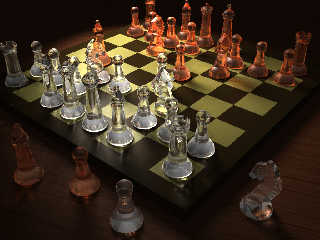
|
 |
|  |
|  |
|
 |
|
 |
|  |
|  |
|
 |
"Warp" <war### [at] tag povray povray org> wrote in message
news:48a9a22c@news.povray.org...
> I tried to shamelessly copy your design with my own chess set, but
> I couldn't get even close...
I'm not putting the OP down here, but when I first looked at the
original image, I thought that there might be some kind of light-source
under selected pieces. It's that good.
Good image Warp, I really like your version too.
~Steve~
> --
> - Warp org> wrote in message
news:48a9a22c@news.povray.org...
> I tried to shamelessly copy your design with my own chess set, but
> I couldn't get even close...
I'm not putting the OP down here, but when I first looked at the
original image, I thought that there might be some kind of light-source
under selected pieces. It's that good.
Good image Warp, I really like your version too.
~Steve~
> --
> - Warp
Post a reply to this message
|
 |
|  |
|  |
|
 |
|
 |
|  |
|  |
|
 |
finished image.
The original image was made to a speed contest with a 1 week deadline, so I
knowledge) to make all the details perfect. On the chessboard you can see a
You can find the source code below (with Hungarian comments):
www.raytracer.hu/temp/chess.pov
it I hope it can be interesting for someone.
Warp, congratulations for your chess-image, very nice work.
Gaf
Post a reply to this message
Attachments:
Download 'gaf_chess-macro.jpg' (253 KB)
Preview of image 'gaf_chess-macro.jpg'
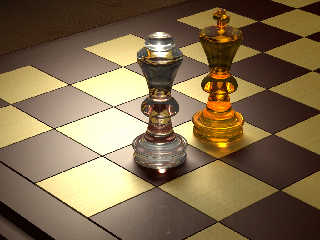
|
 |
|  |
|  |
|
 |
|
 |
|  |
|  |
|
 |
"Gaf" <nomail@nomail> schreef in bericht
news:web.48aa783873b1f4593a6325dd0@news.povray.org...
>
> I'm a beginner in POV-Ray, so the source code is pretty simple, but
> despite of
> it I hope it can be interesting for someone.
>
A beginner??
You achieve way better than me after more than 10 years!!! I am going to
hide inside a deep hole in the ground and never come up again.... :-)
Thomas
Post a reply to this message
|
 |
|  |
|  |
|
 |
|
 |
|  |
|  |
|
 |
"Thomas de Groot" <t.d### [at] inter nlDOTnet> wrote in message
news:48aa8585@news.povray.org...
> A beginner??
> You achieve way better than me after more than 10 years!!! I am going to
> hide inside a deep hole in the ground and never come up again.... :-)
>
> Thomas
haha ..... can i join you? i've been at for sometime as well and have NEVER
gotten the lighting as good as this in any of my work. A very nice example
of what pov can do indeed! I had a photographer in my shop a couple of days
ago. He was photographing some antique pottery (crocks and jugs) for a book.
He was a very nice chap and was willing to put up with me looking over his
shoulder. He had a very bright single light, and used a couple of mirrors to
reflect light to the darker spots not hit by the 1000W light he was using.
The light had two dampers (little flaps) that took away some of the
harshness. He also did something I found really interesting .... slowed down
the shutter speed and moved the mirror from side to side to paint the light
across a the bottom edge of a piece that had a hard to see potters mark. I
really enjoyed watching him as lighting is a very difficult technique to
master (for me)
Jim nlDOTnet> wrote in message
news:48aa8585@news.povray.org...
> A beginner??
> You achieve way better than me after more than 10 years!!! I am going to
> hide inside a deep hole in the ground and never come up again.... :-)
>
> Thomas
haha ..... can i join you? i've been at for sometime as well and have NEVER
gotten the lighting as good as this in any of my work. A very nice example
of what pov can do indeed! I had a photographer in my shop a couple of days
ago. He was photographing some antique pottery (crocks and jugs) for a book.
He was a very nice chap and was willing to put up with me looking over his
shoulder. He had a very bright single light, and used a couple of mirrors to
reflect light to the darker spots not hit by the 1000W light he was using.
The light had two dampers (little flaps) that took away some of the
harshness. He also did something I found really interesting .... slowed down
the shutter speed and moved the mirror from side to side to paint the light
across a the bottom edge of a piece that had a hard to see potters mark. I
really enjoyed watching him as lighting is a very difficult technique to
master (for me)
Jim
Post a reply to this message
|
 |
|  |
|  |
|
 |
|
 |
|  |
|  |
|
 |
"Jim Holsenback" <jho### [at] hotmail com> schreef in bericht
news:48aaa400$1@news.povray.org...
>
> haha ..... can i join you? i've been at for sometime as well and have
> NEVER gotten the lighting as good as this in any of my work. A very nice
> example of what pov can do indeed! I had a photographer in my shop a
> couple of days ago. He was photographing some antique pottery (crocks and
> jugs) for a book. He was a very nice chap and was willing to put up with
> me looking over his shoulder. He had a very bright single light, and used
> a couple of mirrors to reflect light to the darker spots not hit by the
> 1000W light he was using. The light had two dampers (little flaps) that
> took away some of the harshness. He also did something I found really
> interesting .... slowed down the shutter speed and moved the mirror from
> side to side to paint the light across a the bottom edge of a piece that
> had a hard to see potters mark. I really enjoyed watching him as lighting
> is a very difficult technique to master (for me)
>
You are welcome to join me, Jim :-)
Interesting what you tell about that photographer, especially the trick with
the moving light source! Never thought about doing that.
Thomas com> schreef in bericht
news:48aaa400$1@news.povray.org...
>
> haha ..... can i join you? i've been at for sometime as well and have
> NEVER gotten the lighting as good as this in any of my work. A very nice
> example of what pov can do indeed! I had a photographer in my shop a
> couple of days ago. He was photographing some antique pottery (crocks and
> jugs) for a book. He was a very nice chap and was willing to put up with
> me looking over his shoulder. He had a very bright single light, and used
> a couple of mirrors to reflect light to the darker spots not hit by the
> 1000W light he was using. The light had two dampers (little flaps) that
> took away some of the harshness. He also did something I found really
> interesting .... slowed down the shutter speed and moved the mirror from
> side to side to paint the light across a the bottom edge of a piece that
> had a hard to see potters mark. I really enjoyed watching him as lighting
> is a very difficult technique to master (for me)
>
You are welcome to join me, Jim :-)
Interesting what you tell about that photographer, especially the trick with
the moving light source! Never thought about doing that.
Thomas
Post a reply to this message
|
 |
|  |
|  |
|
 |
|
 |
|  |
|  |
|
 |
Nice glass lesson.
1st rule, make sure you have lots of time or power. 2 hrs for 3 pieces.
pong to the script:
(no board maps)
#include "woods.inc"
#declare darkwood = texture
{
T_Wood8
pigment { turbulence 0.1 }
finish { ambient .2 diffuse .6 phong .85 phong_size 50 reflection 0.025 }
scale 2
}
#declare lightwood = texture
{
T_Wood3
pigment {turbulence 0.1}
finish { ambient .2 diffuse .6 phong .85 phong_size 50 reflection 0.025 }
scale .5
}
#macro board_sq(i,p)
#if (i)
object { Round_Box_Union(<-1,-0.01,-1>, < 0,-.25,0>, .01)
texture { lightwood } translate p}
#else
object { Round_Box_Union(<-1,-0.01,-1>, < 0,-.25,0>, .01)
texture { darkwood } translate p}
#end
#end
#macro board()
#local i=0;#local j=0;
#while (i<8)
#local j=0;
#while (j<8)
board_sq(mod(i+j,2),<-3+j,0,-3+i>)
#local j=j+1;
#end
#local i=i+1;
#end
#end
board()
Post a reply to this message
Attachments:
Download 'chess2.jpg' (101 KB)
Preview of image 'chess2.jpg'
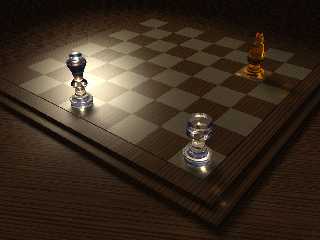
|
 |
|  |
|  |
|
 |
|
 |
|  |
|  |
|
 |
"Gaf" <nomail@nomail> wrote:
> Hi! This is my first finished work with the POV-Ray. Render time: 8h 25min...
>
> Gaf
Your light is one thing giving you so much render time. A 320x240 test (with no
AA) went from 4 minutes to 40 seconds (length of 1, and 1 Knight) with a light
fix: squares the light vectors to direction of travel, plus extra light in
array, wider falloff. (Is it just all those pieces lighting the board or some
other change?)
//vlen = 22.2
#declare _z_ = <3, 0, -3>-<-17, 10.4, 10.4>;
#declare _x_ = vnormalize(vcross(y,_z_))*15;
#declare _y_ = vnormalize(vcross(_z_,_x_))*15;
light_source { <-17, 10.4, 10.4> color rgb <1, 1, .8>
adaptive 50
spotlight
radius 7
falloff 40
point_at <3, 0, -3>
area_light _x_,_y_, 13,13 adaptive 0 jitter orient circular
photons{
reflection on
refraction on
}
}
Array length of 15 (same as orig) for another 20 seconds: total 1 minute versus
4 minutes.
This light gives 5-10 minutes per piece depending on the resolution and power
you have. Expect around 1/3 the render time or two thirds less.
Looks to me like, if you look at the Queen shadows in previous 2 imgs, a skewed
array = skewed shadows.
There is starting to appear more rays from the Knight hitting the board in this
lower res img (corner H5).
aQ
#declare original_light =
light_source {
<-17, 10.4, 10.4>
color rgb <1, 1, .8>
adaptive 50
spotlight
radius 7
falloff 40
point_at <3, 0, -3>
area_light <15, 0, 0>, <0, 0, 15>, 12, 12
photons{
reflection on
refraction on }}
Post a reply to this message
Attachments:
Download 'chess4.jpg' (68 KB)
Preview of image 'chess4.jpg'
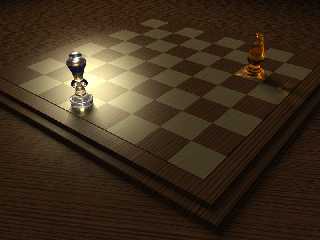
|
 |
|  |
|  |
|
 |
|
 |
|  |
|  |
|
 |
now I see adaptive, 0 must have shut it off, so thats where all the render time
is hiding!
The adaptive command is used to enable adaptive sampling of the light source. By
default POV-Ray calculates the amount of light that reaches a surface from an
area light by shooting a test ray at every point light within the array. As you
can imagine this is very slow. Adaptive sampling on the other hand attempts to
approximate the same calculation by using a minimum number of test rays. The
number specified after the keyword controls how much adaptive sampling is used.
The higher the number the more accurate your shadows will be but the longer they
will take to render. If you are not sure what value to use a good starting point
is adaptive 1. The adaptive keyword only accepts integer values and cannot be
set lower than 0.
now to test what visible difference if any.
Post a reply to this message
|
 |
|  |
|  |
|
 |
|
 |
|  |
|  |
|
 |
"alphaQuad" <alp### [at] earthlink net> wrote:
>
> now to test what visible difference if any.
Adaptive 1 took 20% more time than 0,
and rendered smoother shadow.
Adaptive 10 took same amount of time to do only the Queen's crown, gave up.
go easy on adaptive
//vlen = 22.2
#declare _z_ = <3, 0, -3>-<-17, 10.4, 10.4>;
#declare _x_ = vnormalize(vcross(y,_z_))*15;
#declare _y_ = vnormalize(vcross(_z_,_x_))*15;
light_source { <-17, 10.4, 10.4> color rgb <1, 1, .8>
spotlight
radius 7
falloff 40
point_at <3, 0, -3>
area_light _x_,_y_, 13,13 adaptive 1 jitter orient circular
photons{
reflection on
refraction on
}
} net> wrote:
>
> now to test what visible difference if any.
Adaptive 1 took 20% more time than 0,
and rendered smoother shadow.
Adaptive 10 took same amount of time to do only the Queen's crown, gave up.
go easy on adaptive
//vlen = 22.2
#declare _z_ = <3, 0, -3>-<-17, 10.4, 10.4>;
#declare _x_ = vnormalize(vcross(y,_z_))*15;
#declare _y_ = vnormalize(vcross(_z_,_x_))*15;
light_source { <-17, 10.4, 10.4> color rgb <1, 1, .8>
spotlight
radius 7
falloff 40
point_at <3, 0, -3>
area_light _x_,_y_, 13,13 adaptive 1 jitter orient circular
photons{
reflection on
refraction on
}
}
Post a reply to this message
Attachments:
Download 'chess6.png' (251 KB)
Preview of image 'chess6.png'
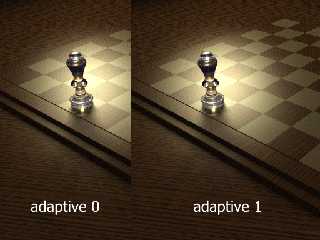
|
 |
|  |
|  |
|
 |
|
 |
|  |
|
 |




![]()